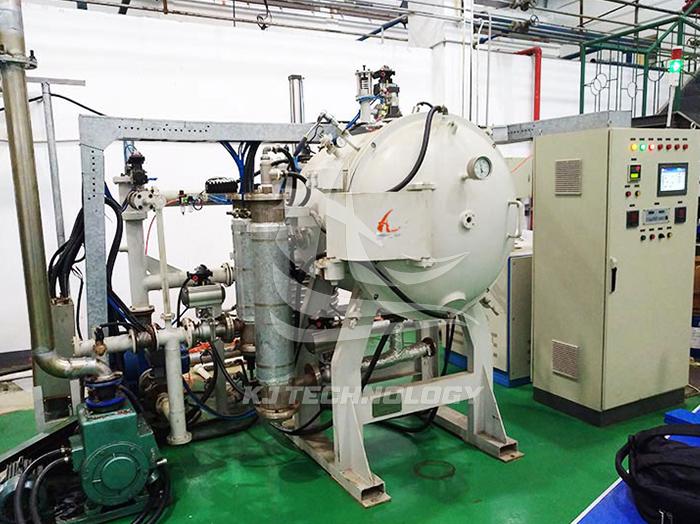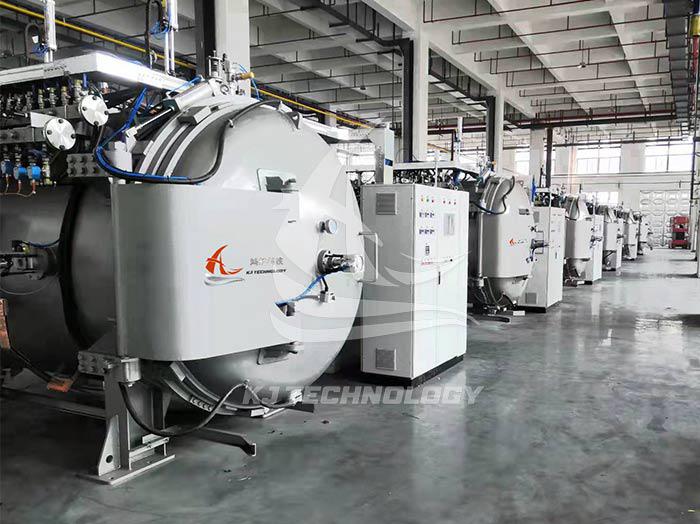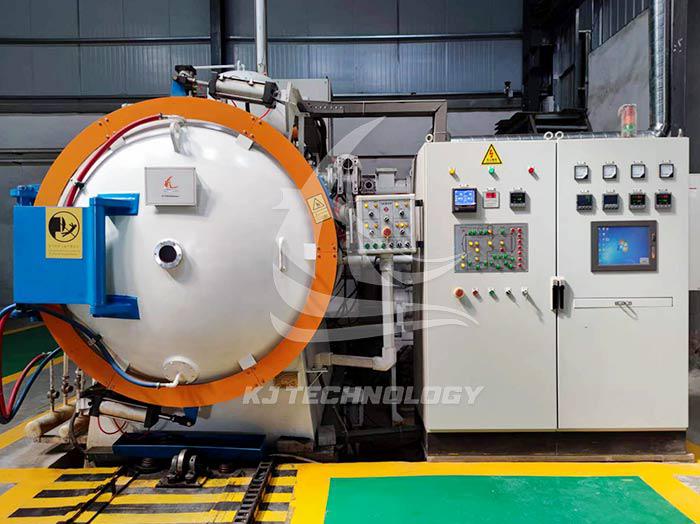Maintenance of vacuum heat treatment atmosphere electric furnace
 06-30-2025 Author: KJ technology
06-30-2025 Author: KJ technology
As a precision heat treatment equipment, the maintenance work of vacuum heat treatment atmosphere electric furnace needs to be carried out around the five core modules of vacuum system, heating system, atmosphere control system, mechanical structure, and electrical system. Through regular maintenance, preventive inspection, and standardized operation, the equipment life can be significantly extended, the process stability can be improved, and the failure rate can be reduced. The following are specific maintenance measures:
1. Daily maintenance (after daily/batch operation)
Furnace body cleaning
Inner wall cleaning: Use a soft cloth or vacuum cleaner to remove residues (such as carbon deposits and oxide scales) inside the furnace to avoid contaminating subsequent workpieces.
Cleaning of observation window: Wipe the observation window with anhydrous ethanol to ensure clear visibility and facilitate monitoring of the furnace's internal conditions.
Water cooling system inspection: Confirm that the cooling water flow rate is normal (generally ≥ 5 L/min), the water temperature is within the range of 20-30 ℃, and there is no water leakage.
Vacuum system inspection
Vacuum pump oil level: Check the oil level of the mechanical pump and diffusion pump to ensure it is above the oil level mark; If the oil is cloudy or contains impurities, it needs to be replaced immediately.
Vacuum valve sealing: Before operation, manually open and close the front stage valve and bypass valve to confirm that there is no jamming or leakage; If the valve sealing ring ages, it needs to be replaced in a timely manner.
Atmosphere system inspection
Gas pipeline connection: Check whether the connections of methane, hydrogen, nitrogen and other gas pipelines are tight, without looseness or leakage.
Zero calibration of gas flowmeter: Perform zero calibration on the flowmeter before daily operation to ensure measurement accuracy.
Safety device testing
Emergency stop button: Press the emergency stop button to confirm that the device immediately stops running and the alarm light is on.
Overtemperature alarm: Simulate overheating scenarios (such as short circuiting thermocouples) and test whether the alarm function is normal.
2. Weekly maintenance (weekly)
Heating system maintenance
Heating element inspection: Use an infrared thermometer to measure the surface temperature of the heating element and confirm that there is no local overheating or open circuit phenomenon.
Thermocouple calibration: Compare the standard thermometer with the measured value of the thermocouple. If the error exceeds ± 2 ℃, calibration or replacement is required.
Pneumatic system inspection
Pneumatic valve action test: Manually trigger the pneumatic valve (such as the charging valve and exhaust valve) to confirm that the action is flexible and there is no jamming.
Compressed air pressure: Check if the air source pressure is stable (usually 0.4-0.6 MPa). If the pressure fluctuates greatly, adjust the pressure reducing valve.
Sealing test of furnace door
Pressure holding test: After closing the furnace door, evacuate to 10 ⁻ Pa and hold for 30 minutes. If the vacuum degree drops by more than one order of magnitude, the sealing ring needs to be replaced.
3. Monthly maintenance (monthly)
Deep maintenance of vacuum pump
Mechanical pump oil change: Drain the old oil, filter it with an oil filter and reuse it (if the oil quality is good), or directly replace it with new oil (recommended to use vacuum pump specific oil).
Diffusion pump cleaning: Disassemble the diffusion pump and clean the inner wall of the pump body and heater with acetone to remove carbon deposits and oxides.
Cooling system maintenance
Water cooling machine cleaning: Clean the dust on the cooling fins of the water cooling machine and check if the water pump impeller is worn; If the water quality is poor (such as containing calcium and magnesium ions), deionized water needs to be replaced.
Gas quenching nozzle inspection: Use an endoscope to observe the inside of the gas quenching nozzle and confirm that there is no blockage or deformation; If the nozzle is worn, a new part needs to be replaced.
Electrical system inspection
Tightening of wiring terminals: Check whether the wiring terminals inside the control cabinet are loose, and tighten them with a torque wrench according to the standard torque (such as 2.5 N · m).
Insulation resistance test: Use a megohmmeter to measure the insulation resistance between the heating element and the furnace body, which should be ≥ 1 M Ω; if it is lower than the standard value, check whether the insulation material is aging.
4. Quarterly maintenance (every 3 months)
Heating element replacement
Graphite tube testing: Use a multimeter to measure the resistance value of the graphite tube. If the deviation from the nominal value exceeds ± 10%, a new tube needs to be replaced.
Molybdenum wire tension adjustment: For molybdenum wire heating elements, check whether the tension is uniform; If there is local relaxation, it needs to be re tensioned and fixed.
Vacuum system leak detection
Helium mass spectrometer leak detection: Use a helium mass spectrometer leak detector to conduct a comprehensive inspection of furnace body, vacuum pump, pipeline and other parts, with a leak rate of ≤ 1 × 10 ⁻⁹ Pa · m ³/s.
Sealing ring replacement: Replace the corresponding sealing ring (such as O-ring, flange gasket) for the leakage point found during leak detection.
Calibration of Atmosphere Control System
Calibration of gas analyzer: Use standard gas (such as nitrogen containing 1% methane) to calibrate the gas analyzer, ensuring accurate measurement of gas concentration in processes such as carburizing and nitriding.
Exhaust gas treatment device inspection: Clean the residue in the burner or chemical absorption tank, and confirm that the exhaust emissions meet the standard (such as CO concentration ≤ 50 ppm).
5. Annual maintenance (every year)
Furnace structure maintenance
Furnace shell deformation inspection: Use a laser level to check the levelness of the furnace shell. If the deformation exceeds 0.5 mm/m, the furnace frame needs to be calibrated.
Insulation layer replacement: Disassemble the furnace body and check whether the ceramic fiber felt or graphite felt insulation layer is damaged; If the damaged area exceeds 10%, a new insulation layer needs to be replaced.
Control system upgrade
PLC program backup: Backup the PLC program inside the control cabinet to prevent data loss.
Software update: Based on the upgrade package provided by the device manufacturer, update the temperature control software, atmosphere control software, etc., and optimize the process parameters.
Safety performance evaluation
Explosion proof performance testing: Simulate hydrogen leakage scenarios and test whether explosion-proof devices (such as hydrogen detectors and automatic exhaust systems) are activated in a timely manner.
Grounding resistance detection: Use a grounding resistance tester to measure the grounding resistance of the equipment, which should be ≤ 4 Ω; If it exceeds the standard, it needs to be re grounded.
6. Special maintenance precautions
Long term disuse maintenance
Vacuum Maintenance: If the equipment is not in use for more than one month, it is necessary to evacuate it to below 10 ⁻ Pa and maintain it to prevent moisture inside the furnace.
Rust prevention treatment: Apply rust prevention oil to uncoated metal parts (such as furnace frames and fixtures) to prevent rusting.
Moist environment maintenance
Heating and dehumidification: During humid seasons (such as rainy season), run the equipment once a week (without workpieces), heat to 150 ℃ and maintain for 2 hours to remove moisture from the furnace.
Desiccant replacement: Place silicone desiccants in the control cabinet, check and replace desiccants that have absorbed moisture and changed color every month.
7. Maintenance records and traceability
Establish maintenance records: Record the time, content, replaced parts, and test data of each maintenance, forming traceable maintenance records.
Data analysis: Analyze equipment failure trends through maintenance records (such as shortening the vacuum pump oil replacement cycle, which may indicate pump body wear), and develop maintenance plans in advance.








